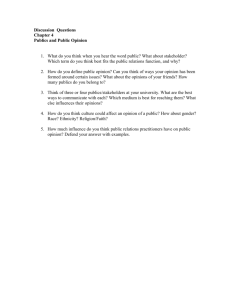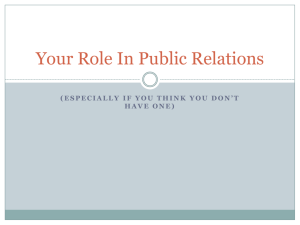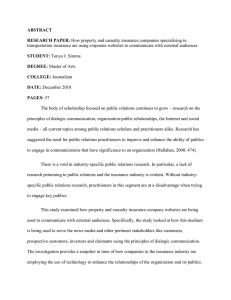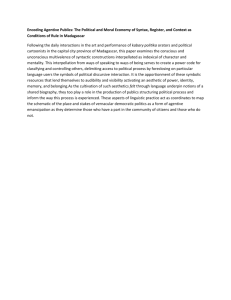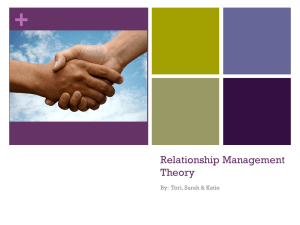Evaluation of the Internal and ... Publics of Ball State University ... Public Relations Efforts and Needs
advertisement
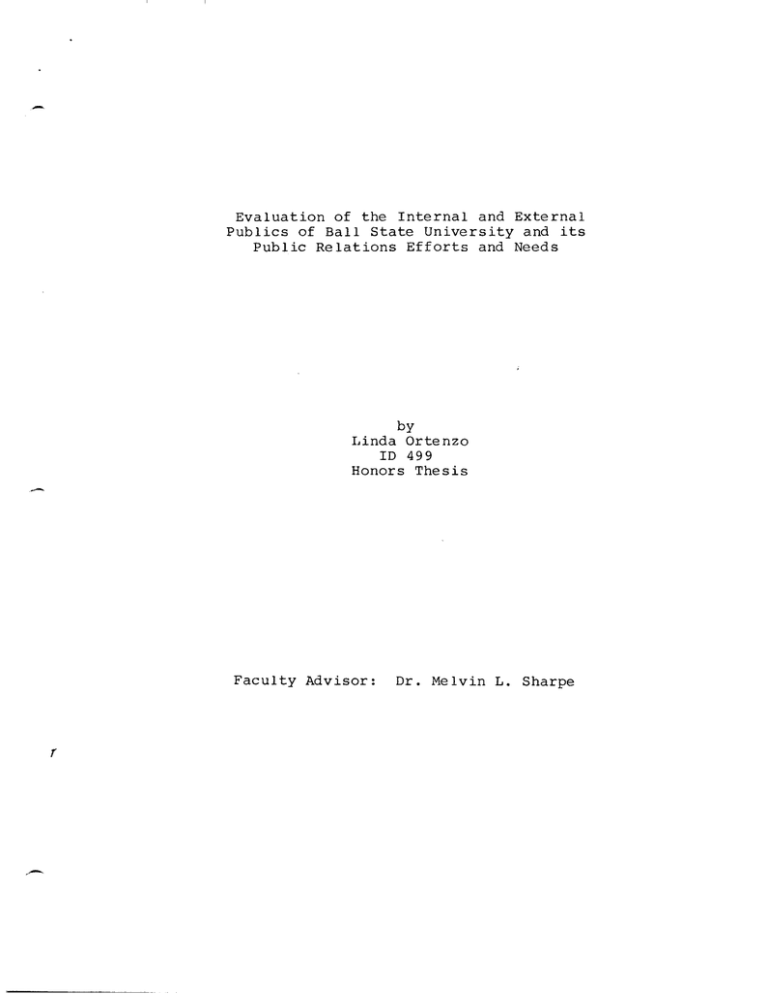
Evaluation of the Internal and External
Publics of Ball State University and its
Public Relations Efforts and Needs
by
Linda Orte nzo
ID 499
Honors Thesis
--
Faculty Advisor:
r
--
Dr. Melvin L. Sharpe
,PROBLEM
Maintaining constant two-way communications with each
public in its constituency is the challenge of every organization which recognizes the importance of public relations in
its daily functioning.
Ensuring that flow of information re-
quires constant surveying of communications processes to target points where a breakdown of communications may occur.
Based on these principles, Ball State University will be analyzed as an organization utilizing public relations according
to the definition of public relations developed by Dr. Melvin
Sharpe, associate professor and corrdinator of the Public Relations Sequence, Department of Journalism, Ball State University, Education Editor for the International Public Relations
Association, Director and National Newsletter Editor for the
Educator Section of the Public Relations Society of America
and Chairman of the national PRSA Continuing Education Board
for 1985.
DEFINITION
Public Relations is the recognition and acceptance on the
part of organizations of the following principles:
-
1.
That the economic and social stability of an organization of any type is dependent upon the attitudes
and opinions of the publics within its total operational environment.
2.
That all men have the right to voice their opinions in
relation to decisions which will directly affect them
and, therefore, have the right to accurate information about pending decisions relating to them or their
we Ifare.
2
3.
The
That an organization's management of communications
is essential to ensure accurate and adequate feedback
from both internal and external publics in' ,order to
assure the organization's adjustment and adaptation
to change necessary for longevity.
~actice
of public relations involves:
1.
The constant evaluation and analysis of the operational
environment and its publics.
2.
The review and analysis of organizational goals,
objectives, policies and procedures for the purpose
of identifying lack of harmony between the organization
and its publics or social environment and the potential
short and long range effect.
3.
The maintenance of open communications to assure the
feedback necessary for management decisions based on
accurate and complete information and to assure the
organization's ability to respond and adjust to change
as required by societal and environmental conditions.
4.
The planning and development of courses of action
designed to project the organization honestly and
accurately in order to earn and maintain the support
and understanding of the publics within the operational
environment of the organization.
Organizations which fail to accept these principles or which
have communications programs which fail to perform the functions
stated, do not practice or perform public relations and, therefore, abuse the term and its professioanl intent.
They also invite the problems that result from poor
communication, resistance to change, managereent decisions
based on inadequate data, and planning and programming which
is stop-gap at best and minimal in terms of long range impact.
Although public relations principles and practice can
certainly be applied and used by individuals, its professional
context relates to groups of individuals with shared missions
perfor~ing
izations.
as profit, non-profit, political, or government organ-
3
,-
METHODOLOGY
The investigation of the university's public relations
practices included extensive one and a half hour interviews with
several distinguished members of the Ball State University
faculty and administration.
Among those interviewed were the
current chairman of the Department of Journalism, two past
chairmen of the Department of Journalism, the former president
of University Senate, the director of the Honors Program,
the vice president of University Relations, coordinator of
the Public Re lations Sequence (Department ,of Journalism),
a top university administrator, and the president of the
university.
Daily news clips from October 1982 to December 1983,
external perceptions survey of Ball State University, and
the April 1984 report from the Commission on Institutions
of Higher Education were reviewed to provide background information.
The analysis will be organized according to subject in
relation to each of the four public relations practices outlined
by Dr. Sharpe.
FINDINGS
The first practice cited involves "the constant evaluation
and analysis of the operational environment and its public!'>."
Analysis
Before this practice can be applied, it is essential that
the purpose and intent of the organization be clearly defined,
and its goals and objectives be established, to provide a basis
-
for analysis.
At this basic level of understanding, Ball State University
4
--
struggles with ambiguity of purpose and lack of direction-a significant strain on the ability of a public relations program
to operate effectively.
The Commission of Institutions of
Higher Education April 1984 report states, "There is no doubt
in the minds of the examiners that IBal1 State University has
clear and publicly stated purposes, consistent with its
mission, and appropriate to post-secondary educational institutions.
Among the various constituents at Ball State University
I
and within the University community, however, there is something
less the unanimous agreement as to the pu~poses of th~ institution.
There is a view that the institution should remain
faithful to its historic mission as a teacher training school
and a view that the institution should move more boldly and
quickly toward becoming a comprehensive, research-oriented
university.
Both views have their partisans.
This clash of
purposes--and the resulting clash of values and visions--has
led to some considerable confusion within the institution and
some puzzlement beyond as to the primary purposes of Ball State
University."
The report goes on to say that "members of the faculty are
still intertwined in the battle of a decade ago.
The reconciliation
of conflicting values--a firm allegiance to an immutable past
or an equally firm devotion to a changing present is, perhaps,
the most formidable task facing the institution."
The problem of defining the purpose and goals of Ball
State University is a major theme in the Commission's report.
It is also a concern echoed in numerous interviews with faculty
\
.~
It1UTi . q I .
tU
i1~.,
5
-
and administration.
Dr. Robert Linson, Vice President of
University Relations, said it's a matter of "interpreting ourselves
to ourselves."
Dr. Conn, Chairman of the Department of Journal-
ism, said there is need to "determine what our focus is."
The
university appears to be much like a mobile whose moving parts
represent various departments and programs--each acting independently of the others, and seemingly bonded only by a narrow
bridge of common interests, instead of united by a common
purpose.
In terms of external perceptions this ambiguity extends
to the public image of the university.
Dr. Arno Wittig, a
Ball St.ate Psychology professor, said there isn't "one thing
that means BSU."
-
In the same tenor, Dr. Popovich, a Ball State
Journal. ism professor, said, "There is no unif ied Ba 11 State
image. "
Evaluat.ion
In regard to this problem, it would be of great benefit to
the university to employ a public relations professional to
oversee and coordinate all the public relations efforts in
various administrative offices, as well as advise in policy
making, such as establishing goals and objectives of the
university.
Such a move would provide a cohesive effort in
sound public relations practice, and ensure a means of creating
university policy consistent with its goals and objectives.
Since the true practice of public relations requires
that image be based on truth, the goals and objectives of the
university must not only be defined, but agreed upon by faculty
6
-
and administration to establish an unity of purpose, and
provide a vehicle for directing university policy.
Accomplishing
this task is also paramount to the success of the efforts
involved in the second practice of public re lations out lined
by Dr. Sharpe--"The review and analysis of organizational goals,
objectives, policies and procedures for the purpose of identifying
lack of harmony between the organization and its publics or
social environment and the potential short and long range effect."
Identify~Lack
of Harmony
The problem of agreement on purpose a,nd direction is
instrumental in the discussion of this point.
It related speci-
fically to what the Commission on Institution of Higher Education
calls "a degree of acrimony" observed by several relatively
new faculty members regarding the ongoing debate over the Ball
State past versus Ball State present.
They said it "character-
ized so much of the public discourse about the university."
Teache:t_"s are a particular ly noticeable group when identifying
a "lack of harmony" between the university and its publics.
Several faculty members commented on a kind "we/they" mentality
existing between themselves and the university administrators.
Dr. Popovich said, "There is a reluctance to involve faculty
in anything administrative."
Dr. Ing lehart said, "They (admini-
strators) have not really done well in their faculty relationships."
"During the last three years, they have demonstrated
an antagonism toward faculty members, and as a result, faculty
morale and participation and involvement ha,s deteriorated to
disasterous levels.
They (administrators) have really not
7
,-
recognized the purpose of public relations which is to establish
a program of continuous two-way communications so that the
publics which are important to you can come to understand and
perhaps identify your objectives as being compatible with the
objectives of that public.
Faculty is a tremendously important
public."
While teachers are one of the most important publics in
the university structure, there are several other publics
which the university must recognize: current students, prospective students, parents, Muncie residents, local officials,
state leg is lat.«Drs,
alumni, staff, and the Dai ly News.
In
regard to a discussion on the policies and procedures of the
university(the last section of the second public relations
practic'~
cited) there is perhaps no incident in recent years
which better illustrates the effects of university practices
on the attitudes of its various publics, than the Daily News
investigation of the investment practices of Ball State University.
Policies and Procedures:
Short and Long Range Effects
State Board of Accounts spokesman Michael Clayton and SBA
director N. F. Renner termed the university practice of investing
solely in local banks, "bad business."
Renner said the practice
could have cost the university hundreds of thousands of dollars.
From several concurring views of business professors from other
universities and past administrators quoted in the Daily News,
the investment policy was deemed unwise.
From a public relations
standpoint its effects were just as far reaching.
It appears obvious that when the university adopted that
policy, little attention was given to the appearance of the
8
situation--or the message it might be communicating.
Former
president Anderson said "The conflict of interest possibility
is not a new question."
"I raised the question of total locril
investing when I was there as president," he said.
Despite
his concern, the policy did not change.
When the investment stories began, and the ensuing legal
battles occurred, the administration became engulfed in a flood of
public inquiry over the situation.
Former president Bell said
the impact of the artic les was "pretty severe."
Alumni and
potential donors contacted him with questions about the issue,
he said.
He wasn't sure at that point if those people would
still make donations.
"One donor who gave a sizable estate
said, 'Maybe my donation was a mistake.
I don't live in the
state and just saw the headlines.'"
At least in part, however, the furor caused by the issue
was due to the manner in which the administrators responded to
the investigation.
Another crucial aspect of public relations
is open communications, as is documented in the third public
relations practice cited by Dr. Sharpe, "the maintenance of
open communications to assure the feedback necessary for
manageml~nt
decisions based on accurate and complete information
and to assure and organization's ability to respond and adjust
to change as required by societal and environmental conditions."
The administration at that time did not fOllow a policy of
open communications.
Open Communications
When asked by the Daily News to explain their reasoning for
9
-
engaging in such business practices, administrators balked at
the student reporters saying "an answer isn't justified."
Then president Bell verbally attacked the student press several
times, and even barred chief reporter Don Yeaser from his office.
Dr. Ing lehart said, "They established an atmosphere of confrontation which damaged them a great deal."
strator said, "They got defensive."
One university admini-
"I don't think you ever
win when you attack the press, II Dr. Sharpe said, "even a student
operated newspaper.
II
The important consideration reiterated in several interviews
was the fact that student reporters were involved and that the
student press is a learning instrument.
Dr. Vander Hill, director
of Honors, said one reason for the problems is the Daily
News is the largest most identifiable anti-administration group
on campus.
One university administrator said because the Daily
News is a journalistic lab experience, it should be respected
but not regarded as a continuing threat to administrators.
He also said through the investments issue, the administration
learned that public opinion is worth something.
Perhaps with
this understanding the university will begin to change its
policies to allow more openness in communications.
The administration has long been perceived by students
and faculty as hesitant to discuss problems openly.
With regard
to recurring incidents of rape on campus, rumors of the number
and location of rapes occurring spread rapidly.
Some students
said they felt the university was hiding information on the
-
frequency of rapes, and trying to minimize the danger to women
10
on campus.
One administrator said they should be more open
in discussing problems such as this and not to try to hide so much.
Respond and Adjust to Change as Required by Societal and
Environmental Conditions
Vice President of University Relations, Robert Linson,
said it's one of the more "ticklish" aspects of public relations-"How do you handle the problem without covering it up, being factual, and informing people of potential danger to them."
In re-
gard to parents, he said, "It's a matter of confidence in the
institution.
Years ago we tried to hide these things.
Those
days are gone forever."
Apparently his view of openness is not shared by all who are
concerned about receiving full disclosure of pertinent information.
-
The question of confidence in the institution is addressed here.
Confidence is a product of honesty and trust in all types of relationships.
By dealing directly and openly with problems involving
the security of students, financial integrity of the university,
or the willingness to respect the needs and concerns of faculty,
the university can build confidence in its ability to operate
efficie~tly
and in the best interest of those affected by its pol-
icies.
This is the main intent of an internal relations program,
vital to the success of any organization.
A public relations pro-
fessional hired specifically to handle internal relations would
be pivoltal in easing the ongoing internal stresses of the university.
-
A plan of continuing communications with various publics
could eliminate
frightened,- defensive responses to serious ques-
tions, and provide a means of addreSSing crucial issues in a
11
-
productive manner.
Heeding this advice would be a positive step toward implementing the fourth practice of public relations stated by Dr.
Sharpe: "The planning and deve 1 opment of courses of action designed to project the organization honestly and accurately in
order to earn and maintain the support and understanding of the
publics within the operational environment of the organization."
Courses of Action
Some publics are very well recognized, such as prospective
students.
The university does an admirable job of recruiting
students.
It distributes brochures, pamphlets, personalized form
letters, and utilizes many other forms of communication.
problem is keeping the students here once they arr ive.
The
For a
number of reasons a high percentage of students drop out of Ball
state after their first year.
Disseminating information to students who do stay is another
public relations struggle.
Dr. Sharpe said there is not one
means of communication to reach all students.
You will always
have those who miss information no matter how well you relay it,
he said.
Dr. Linson said relating to students is one of the
greater weakness of the university.
matter of attitude.
Dr. Popovich said it's a
He said sometimes students are regarded as
a bother rather than recognized as the reason the university
exists.
It is ironic that the administration is seen as holding
this attitude since one of the university's most marketed attributes is the caring attitude of faculty torward students.
,-
It
sets up an interesting parallel between administrators' attitudes
towards students rand re lations between administration and faculty.
12
Anong the publics favored by the university, the conservative, Republican community ranks high.
Dr. Inglehart said,
"they {administrators) have worked hard to ingraciate themse lves
to the money element."
Arno Wittig- also said
the(~university
makes a considerable effort to gain the support of this community.
In regard to other publics such as alumni, however, Dr. Wittig
said there are mixed reactions, particularly about the alumni
office and the work they do.
he said.
"Some people feel it's tremendous,"
There are others who strongly disagree, he added, citing
past issues of the alumni newsletter whicb contained apalling
gramatical errors.
It doesn't serve to promote the quality of
Ball State University as a learning institution, he said.
Conclusions
Measuring the reactions of each public toward Ball State
University is a difficult but necessary task.
External studies
have been conducted, but given the scope of the issues discussed,
it appears the university would benefit greatly from an extensive
internal study as we 11.
At the end of each interview, the sub-
ject was asked what he would do if he had the opportunity to direct policies to eliminate some of the problems discussed.
responses were given repeatedly.
Three
They were: 1) establish a unity
of purpose 2) restructure the administration, eliminate large
numbers of unnecessary positions 3) focus on improving internal
relations.
Some of the suggestions involved dramatic change in university
structure and policy.
There appears to be no nondisruptive way to
resolve some of the crucial issues facing the university.
It is
not to say that individuals should be treated insensitively,
13
however '.
Strong leadership is imperative in formulating the
types of policies necessary to direct the university on a well
thought out course.
Strong leadership requires strong support,
and can also evoke substantial opposition.
The importance of
public relations would be evident in providing a bridge between
those who do not readily accept change and those who advocate
change.
It would also be a function of public relations to en-
courage the administration to engage in continuous communications
with its various publics to explain new policies.
Continuous two-way communications is;the key to the success
of any public relations program.
A planned program of internal
and external relations should be adopted to serve the extensive
communications needs of the university.
A public relations pro-
fessional employed to oversee all of the public relations efforts
handled by various offices, and to advise administrators in policy making, would provide the cohesion necessary to implement
coordinated, effective policies in attaining the goals of the
outlined programs.
Confidence in the university would be increased
through open communication, and a program for handling crises
would eliminate rash or defensive responses.
It. is imperative that adminstrators be advised on the importance of public relations in regard to themselves as well as the
university.
The manner in which they propose and implement policy
is critical in acquiring and maintaining the degree of support
they need to carry out their functions in the university.
There
is a great deal of optimism that the new president can establish
a forum for open cOIlU)1unications to improve university re lations at
14
-
all levels.
A commitment to a sound program of public relations
must besrin with his office.
Since maintaining two-way communica-
tions is a challenge to every organization, the new president can
affect change to maintain the necessary channels of communication.
He can--if he accepts the challenge •
-
.
